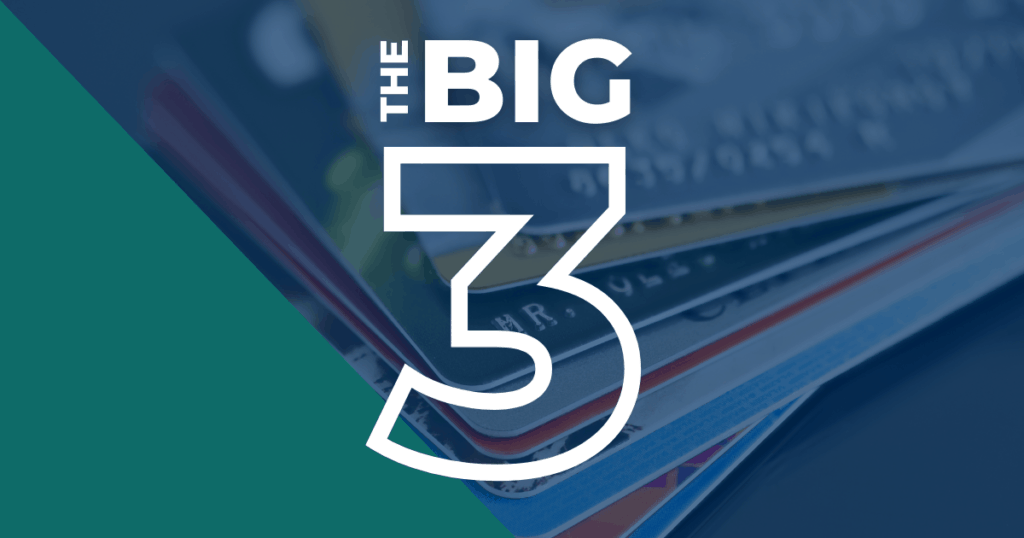If you pay off your credit card bills in full every month, I’ve come up with a brand new strategy to help you maximize cash back rewards.
It’s called The Big 3:
The Big 3 is a credit card rewards strategy to earn the maximum amount of cash back. It requires three credit cards (Flexible, Fixed and Wild) that are selected based on your personal spending habits.
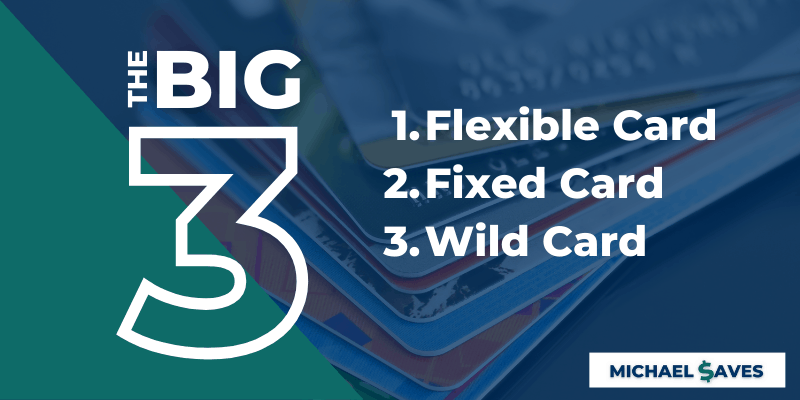
What Is The Big 3 and How Does It Work?
I developed The Big 3 after analyzing my last $20,000 in personal credit card spending across multiple types of cards.
Here’s what surprised me: After reviewing credit card statements, I learned that 78% of my spending was on purchases that DO NOT qualify for any bonus cash back.
How is that possible? I have cards that offer bonus cash back on groceries, dining, gas, travel and more.
But when I analyzed my transactions, non-bonus categories like general merchandise, supplies, health care, bills and utilities made up the majority of my spending.
I concluded that cards with bonus categories aren’t enough. You need a credit card for “everything else.”
That’s where The Big 3 comes in. After crunching the numbers, I determined that I can earn more cash back by reducing the number of credit cards in my wallet to three and using them for very specific purposes.
Michael’s Big 3 Credit Cards:
- Flexible Card: Citi Custom Cash
- Fixed Card: Citi Double Cash Card
- Wild Card: Chase Freedom Flex
The Big 3 includes a Flexible Card, a Fixed Card and a Wild Card. This article will explain my strategy and how it can help you earn the most cash back rewards with every purchase.
Let’s review the three types of cards that are part of this method. We’ll begin with the Flexible Card.
1. Flexible Card
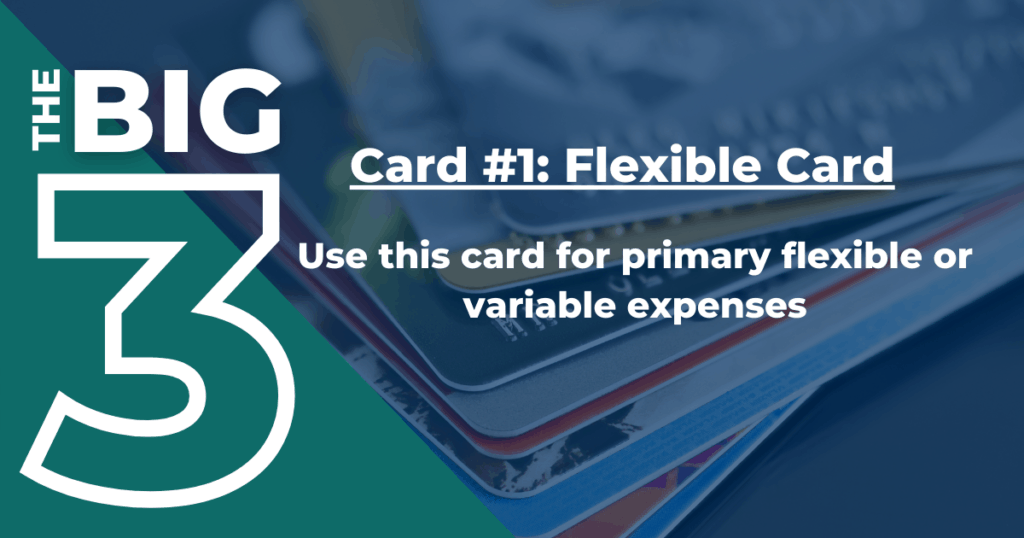
The Flexible Card is a cash back rewards credit card to use for select flexible or variable expenses. Ideally, you want a card that rewards 4% to 6% cash back on purchases in at least one primary category.
To choose the best card, look at your monthly budget or past credit card statements to view your spending history. Then, identify your top flexible spending categories.
Some examples may include:
- Groceries
- Restaurants
- Entertainment
- Transportation (Gas)
- Warehouse Clubs
- Home Improvement
- Clothing
Let’s use groceries as an example. The Blue Cash Preferred® Card from American Express awards 6% back at U.S. supermarkets on up to $6,000 per year in purchases, then it drops to 1%. Terms apply.
If you spend $500 a month using the card at U.S. supermarkets, you’ll earn $360 cash back in a year.
The Blue Cash Preferred Card from American Express also offers 6% cash back on select U.S. streaming services and 3% cash back at U.S. gas stations and on transit. It has a $95 annual fee after the first year.
I used this card for years as my Flexible Card because food is one of my major spending categories.
However, in 2024, I dropped Blue Cash Preferred because of the annual fee. Instead, I use Citi Custom Cash to get 5% back on groceries on up to $500 in spending per month.
So, I am losing 1% in cash back on groceries but no longer paying the $95 annual fee.
Citi Custom Cash offers 5% back on your top eligible spending category. For that reason, I only use Citi Custom Cash on groceries. Nothing else!
Other eligible categories include restaurants, gas stations and home improvement stores.
If you select a Flexible Card that offers bonus cash back for the purchases that you make on a regular basis, this could be the most valuable type of card in your wallet.
2. Fixed Card
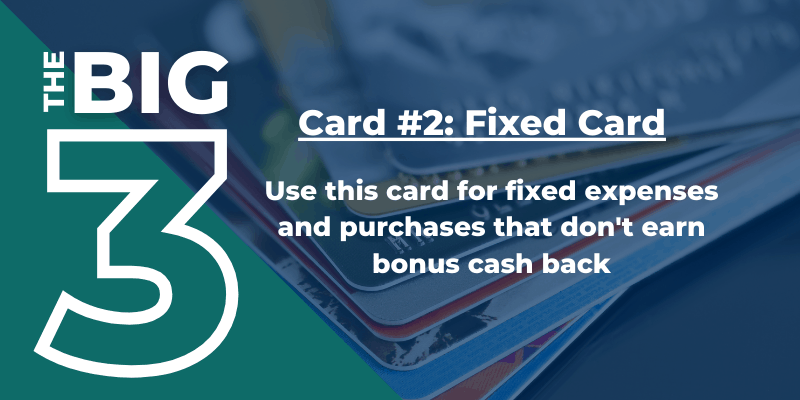
The Fixed Card is the second credit card that you’ll want to carry. It should be used for fixed expenses that you pay by credit card and any purchases that don’t qualify for bonus cash back with other cards.
For this type of card, look for 1.5% to 2% cash back on all purchases with no limits on what you can earn.
My Fixed Card is the Citi Double Cash Card. With this card, you earn an unlimited 1% back when you make a purchase and another 1% back when you pay it off. That’s a total of 2% cash back.
When you see 2% cash back, it’s not all that impressive. But this card is important for one simple reason:
Most credit cards that offer bonus cash back in select categories will only reward you 1% back when you use that same card for purchases that don’t qualify for the bonus.
Remember, $15,600 of my last $20,000 in credit card spending (78%) didn’t qualify for a bonus. That figure includes fixed expenses like insurance, memberships and utilities.
If I used my Flexible Card for all of those purchases at a 1% cash back rate, I would earn $156. However, the cash back doubles to $312 for those purchases with my 2% back Fixed Card.
3. Wild Card
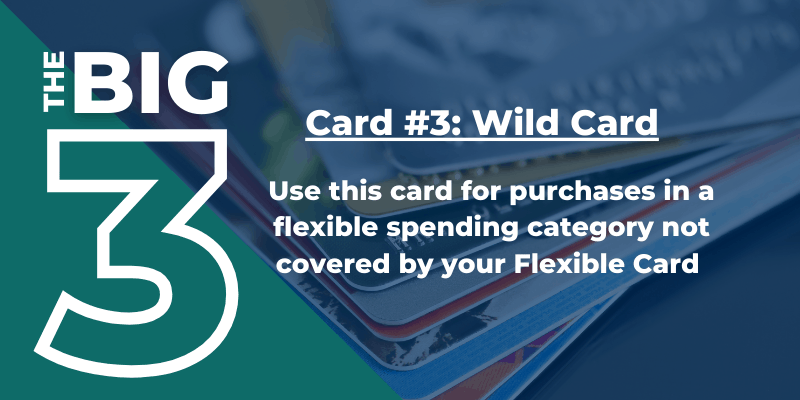
The optional Wild Card rounds out my credit card strategy. The purpose of this card is to earn bonus cash back in a flexible expense category that’s not covered by your Flexible Card.
For this card to work for you, the bonus cash back should be more than the 1.5% to 2% that your Fixed Card pays.
One solid option is Chase Freedom Flex. This improved version of Chase Freedom offers 5% cash back in rotating categories that change every quarter, but that’s not all.
- 5% back in quarterly bonus categories (up to $1,500 in combined purchases)
- 5% back on travel purchased through Chase Ultimate Rewards
- 3% back on dining
- 3% back on drugstore purchases
- 1% back on all other purchases
Chase Freedom Flex is my Wild Card because it offers 3% back on dining and drugstore purchases, which aren’t included as bonus categories with my Flexible Card. The rotating 5% categories make it even better.
I wouldn’t use this card for non-bonus categories, but I could break that rule for my cell phone bill. Here’s why:
When you pay your cell phone bill with Chase Freedom Flex, you get free cell phone protection. If your phone is damaged or stolen, you can get up to $800 per claim after a $50 deductible.
Not all credit cards offer free cell phone protection, but I consider it a valuable perk. In fact, I rely on this benefit instead of paying $10 to $15 per month for insurance from my wireless provider.
When choosing a Wild Card, look for this combination of bonus cash back and cardmember benefits.
What About Travel Rewards Cards?
The Big 3 focuses solely on cash back rewards, not airline miles or hotel points. From my experience, cash back cards are best for most people when you look beyond the one-time welcome bonus.
I still have one travel card in my wallet. But after redeeming the sign-up offer, I’ve found that it takes a very long time to earn that second free flight or hotel stay.
That’s because I don’t travel or spend enough to make those cards the focus of my rewards strategy.
For high-volume spenders who travel a lot, a different approach may be appropriate. When I traveled once a month or every other month, airline and hotel cards made more sense.
If you want to incorporate an existing travel rewards card into The Big 3, I suggest using it as your Wild Card.
Action Plan: Your Next Steps
Are you ready to earn more cash back on your credit card purchases? If you want to get started with The Big 3 credit card strategy, here’s what I recommend:
- Review Your Budget: Determine your top variable spending categories by analyzing your budget and/or past credit card statements.
- Identify Your Big 3: Research options for your Flexible Card, Fixed Card and Wild Card. This may include cards that you already have. Protect your credit score by not applying for multiple cards at once.
- Track Your Cash Back: Evaluate your progress and redeem your rewards for cash back or statement credits.
One final note: If you use rewards credit cards, always make sure to pay off your balances in full every month. Otherwise, you’ll be paying more in interest than you’ll earn in cash back.
What are your Big 3 credit cards to maximize cash back rewards? Let me know in the comments below!
More Content From Michael Saves:
- 3 Best Credit Cards With Free Cell Phone Protection
- Why I Pay My Credit Card Bills Every Single Week
